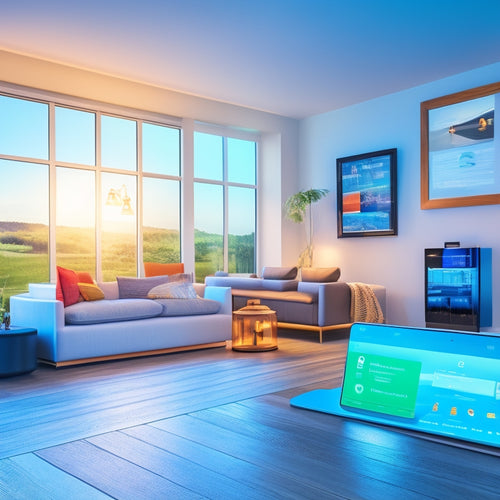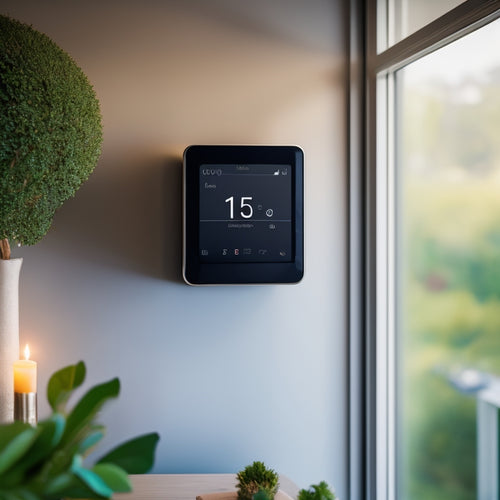
7 Best Tools for Conducting a DIY Energy Audit
Share
You can conduct an extensive DIY energy audit using a range of specialized tools. For real-time energy monitoring, employ smart plugs and energy monitoring systems to track consumption patterns and detect inefficient habits. Identify heat loss with infrared thermometers and air leak detection kits, and assess ventilation and insulation with DIY tests. Optimize lighting with energy-efficient bulbs and occupancy sensors. Finally, analyze your findings with whole-house energy assessment software. By employing these 7 essential tools, you'll be well-equipped to identify areas of energy waste and develop a plan to optimize your home's energy efficiency - and there's more to find.
Key Takeaways
- Real-time power monitoring tools track energy usage and identify consumption patterns to optimize energy habits and detect energy-wasting habits.
- Smart plugs and energy monitoring system devices provide real-time energy tracking, identifying inefficiencies and facilitating adjustments to reduce consumption.
- Infrared thermometers and air leak detection kits are essential for detecting heat loss and air leaks during energy audits, reducing energy waste and utility bills.
- Lighting efficiency audit tools, such as light meters, help optimize lighting usage by replacing inefficient bulbs and utilizing natural lighting.
- Whole-house energy assessment software, like EnergyPlus and OpenStudio, analyzes home energy usage, providing recommendations for improvement and identifying areas of energy waste.
Infrared Thermometer for Heat Loss
Heat loss detection is a significant aspect of energy auditing, and an infrared thermometer is an important tool in your arsenal. With this device, you can quickly identify areas of heat loss in your home, which is essential for optimizing energy efficiency.
Thermal imaging capabilities allow you to visualize temperature differences, making it easier to pinpoint issues. In addition, incorporating solar-powered charging solutions can further reduce energy waste and promote energy independence.
By detecting heat loss, you can take corrective action to seal gaps, add insulation, and improve your home's overall energy performance. This leads to reduced energy waste, lower utility bills, and a more comfortable living space.
As you conduct your DIY energy audit, an infrared thermometer is an indispensable tool for uncovering hidden heat loss and taking control of your energy consumption.
Smart Plug for Appliance Analysis
You can use smart plugs to assess the energy consumption of individual appliances, gaining knowledge into their real-time power usage and tracking their accurate energy expenditure.
By monitoring appliance performance, you can optimize their operation and reduce energy waste.
Moreover, considering the long-term savings of electric vehicles on fuel costs fuel savings can also contribute to an overall more energy-efficient household.
In addition, installing a home charging station for your EV can also reduce costs and enhance your ownership experience.
Appliance Energy Consumption
By plugging appliances into smart outlets, homeowners can gain useful observations into their energy consumption patterns.
This analysis helps identify areas for improvement, enabling you to make informed decisions about energy efficient appliances and optimize your energy usage.
Additionally, understanding the installation costs of commercial EV charging stations, such as Level 2 Charging Stations charging station costs, can also provide significant understandings for energy efficiency optimization.
-
Energy efficiency optimization: Identify appliances with high energy consumption and replace them with energy efficient alternatives.
-
Appliance lifespan analysis: Determine the remaining lifespan of your appliances and plan for replacements or maintenance.
-
Cost savings: Reduce your energy bills by identifying and addressing energy-wasting appliances.
- Environmental impact: Lower your carbon footprint by reducing energy consumption and promoting sustainable living.
Real-Time Power Monitoring
How accurately can you pinpoint the exact moment when your appliances start consuming excessive energy? With real-time power monitoring, you can.
This DIY energy audit tool involves plugging your appliances into smart plugs that track energy usage in real-time. You'll gain understanding into your consumption patterns, identifying when and how your devices are guzzling power.
For instance, you can monitor energy usage patterns to optimize charging schedules and identify inefficiencies, just like in EV charging systems. By doing so, you'll be able to detect energy-wasting habits and adjust your daily routines accordingly.
This data enables you to make informed decisions about your energy usage, optimizing your habits to reduce waste and lower your bills.
Accurate Usage Tracking
Within minutes of plugging in your appliances, the smart plug for appliance analysis begins to yield significant observations, providing an accurate depiction of your energy consumption.
This device enables you to take control of your energy usage patterns, allowing you to identify areas of inefficiency and make data-driven decisions to optimize your energy usage. By adopting a hybrid approach to energy management, as seen in solar-powered EV charging stations, you can maximize energy efficiency and reduce costs.
Track your energy usage in real-time, down to the minute.
Identify which appliances are consuming the most energy and when.
Customizable tracking software: Set up personalized alerts and notifications to stay on top of your energy usage.
Historical energy usage data: Analyze your energy usage patterns over time to identify trends and opportunities for improvement.
Air Leak Detection Kit Essentials
You'll need a few essential items in your air leak detection kit to identify and seal energy-wasting gaps in your home's envelope.
A blower door is a vital component, as it depressurizes your home, making it easier to detect air leaks.
You'll also need a smoke pen or incense sticks to visualize air movement, helping you pinpoint leaks.
Additionally, consider investing in a thermal imaging camera, which can detect temperature differences that indicate air leaks.
This extensive kit will allow you to identify and seal gaps, reducing heat loss and energy waste.
Energy Monitoring System Devices
You'll need devices that provide real-time energy tracking to monitor your home's energy usage.
Home energy sensors will help you identify areas of inefficiency, and wireless data transmission will guarantee seamless communication between devices.
Real-time Energy Tracking
Several devices are available that provide real-time energy tracking, allowing homeowners to monitor their energy consumption as it happens.
With real-time energy tracking, you can identify areas of inefficiency and make adjustments to reduce your energy usage. This type of tracking provides useful revelations into your energy usage patterns, enabling you to make informed decisions about your energy consumption.
Here are some benefits of real-time energy tracking:
-
Immediate feedback: Get real-time feedback on your energy usage, allowing you to adjust your behavior accordingly.
-
Identify energy-intensive appliances: Track energy consumption of individual appliances to identify areas of inefficiency.
-
Optimize energy usage: Use real-time data to optimize your energy usage and reduce waste.
- Cost savings: Make informed decisions to reduce your energy consumption and lower your energy bills.
Home Energy Sensors
Four key devices play an essential role in home energy monitoring: whole-home energy monitors, branch circuit monitors, individual appliance monitors, and plug-in monitors.
These home energy sensors help you track your energy usage, identify areas of inefficiency, and optimize your consumption. Whole-home energy monitors provide a thorough view of your energy usage, while branch circuit monitors focus on specific circuits.
Individual appliance monitors and plug-in monitors give you granular perspectives into the energy consumption of individual devices. By integrating these sensors into your home automation system, you can create a smart home that learns your habits and adjusts energy usage accordingly.
This enables you to take control of your energy consumption and make data-driven decisions to reduce your carbon footprint.
Wireless Data Transmission
Wireless data transmission plays an essential role in energy monitoring system devices, enabling seamless communication between sensors and the central hub. This allows you to collect data from multiple points in your home without the hassle of cables.
With wireless data transmission, you can easily monitor your energy usage in real-time, making it easier to identify areas for improvement.
Here are some key benefits of wireless data transmission in energy monitoring systems:
-
Easy installation: Wireless sensors can be placed anywhere in your home, eliminating the need for complicated wiring.
-
Real-time monitoring: Receive instant updates on your energy usage, enabling you to make timely adjustments.
-
Scalability: Add or remove sensors as needed, without worrying about complicated rewiring.
- Cost-effective: Wireless sensors are often more affordable than their wired counterparts, making energy management more accessible.
Lighting Efficiency Audit Tools
When inspecting your home's lighting, look for opportunities to replace traditional incandescent bulbs with more energy-efficient alternatives, such as LEDs or CFLs, which can greatly reduce energy consumption.
LED upgrades can be a cost-effective way to save energy, and they often last longer than traditional bulbs. Consider installing occupancy sensors or timers to optimize lighting usage.
Don't forget to assess natural lighting in your home. During the day, open curtains and blinds to let natural light in, reducing the need for artificial lighting.
Use a light meter to measure the amount of natural light in each room, identifying areas where you can reduce artificial lighting.
DIY Ventilation and Insulation Test
As you move on to assess your home's ventilation and insulation, identify areas where air leaks and heat loss occur, since these can greatly impact your energy consumption.
To conduct a thorough DIY ventilation and insulation test, follow these steps:
-
Inspect ducts and vents: Check for damage, rust, or gaps in your ductwork and vents, as these can lead to energy loss and poor air quality.
-
Check for air leaks: Use a candle or incense stick to detect air leaks around windows, doors, and electrical outlets.
-
Evaluate insulation materials: Verify that your attic, walls, and floors have adequate insulation materials, such as fiberglass, cellulose, or spray foam.
- Develop ventilation strategies: Consider installing whole-house fans, heat recovery ventilation systems, or solar-powered ventilation systems to improve indoor air quality and reduce energy consumption.
Whole House Energy Assessment Software
Your energy audit expedition now takes you to the domain of whole house energy assessment software, a powerful tool that helps you pinpoint areas of energy inefficiency in your home. This type of software uses energy modeling tools to analyze your home's energy usage and provides recommendations for improvement. You can input data on your home's size, insulation, windows, and HVAC system to get a thorough report on energy losses and potential savings.
| Software | Key Features |
|---|---|
| EnergyPlus | Advanced energy modeling, detailed reports, and customizable inputs |
| OpenStudio | Integration with other energy audit tools, 3D modeling capabilities, and cloud-based simulation |
| REM/Rate | Extensive energy analysis, detailed reports, and compliance with energy standards |
Using whole house energy assessment software, you'll be able to identify areas of energy waste and prioritize improvements to achieve maximum energy efficiency.
Frequently Asked Questions
Can a DIY Energy Audit Really Save Me Money on Energy Bills?
Like a detective searching for clues, you're on the hunt for cost savings. Conducting a DIY energy audit can be your magnifying glass, revealing areas for improvement and unblocking energy efficiency, ultimately leading you to slash your energy bills and savor the sweet taste of financial freedom.
How Long Does a Typical DIY Energy Audit Take to Complete?
You'll spend around 2-4 hours conducting a DIY energy audit, depending on your home's size and complexity, requiring effective time management to optimize audit duration and uncover opportunities for energy-saving improvements.
Do I Need to Be an Expert to Conduct a DIY Energy Audit?
You don't need extensive expert knowledge to conduct a DIY energy audit, but having some understanding of energy efficiency principles helps; with basic tools and a systematic approach, you can identify areas for improvement and take control of your energy consumption.
Can I Do a DIY Energy Audit in a Rented Apartment or House?
You can conduct a DIY energy audit in a rented apartment or house, but consider the rented property's limitations and your tenant energy rights, ensuring you respect the landlord's property while identifying opportunities for energy efficiency.
Are DIY Energy Audit Tools Expensive and Hard to Find?
You'll be relieved to find that DIY energy audit tools aren't as elusive as a needle in a haystack; instead, you can uncover cost-effective solutions and accessible resources that fit your budget, giving you the freedom to optimize your energy usage.
Related Posts
-

10 Best WiFi Outlets for Tracking Home Energy Usage
You can optimize your home's energy usage with the right WiFi outlets, which provide real-time monitoring and control...
-

Smart Energy: Greener Homes With Connected Power Devices
You can control and optimize your energy consumption with smart energy devices, reducing your carbon footprint by up ...
-

3 Earth-Loving Furniture Tips for Energy-Smart Homes
When furnishing your energy-smart home, you have the power to reduce your carbon footprint greatly by making consciou...


